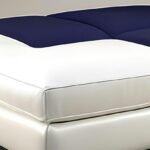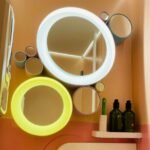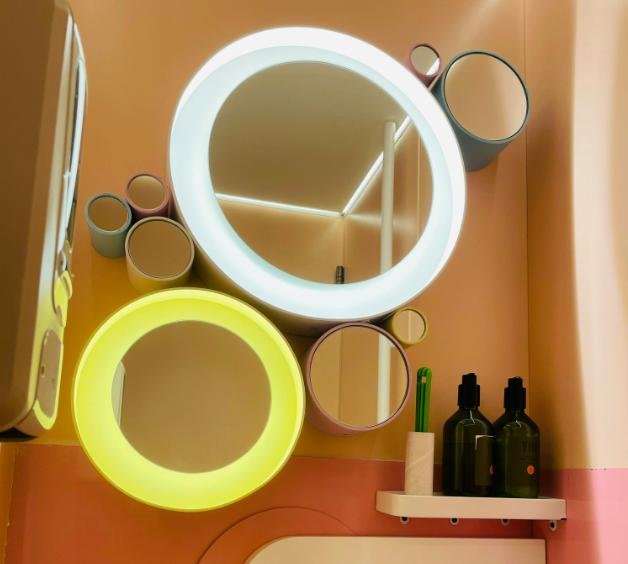Introduction to LED Bathroom Mirrors
LED bathroom mirrors have gained significant popularity in contemporary design, blending functionality with aesthetic appeal. These mirrors are not mere reflective surfaces; they are sophisticated lighting solutions that enhance the overall ambiance and usability of a bathroom. The integration of LED technology in mirrors provides illumination that is energy-efficient, long-lasting, and versatile, making it a practical choice for homeowners who desire both style and sustainability.
One of the key features of LED bathroom mirrors is their built-in lighting, which can be adjusted to create different moods or levels of brightness. This allows for optimal visibility whether applying makeup, shaving, or simply preparing for the day ahead. Many models are equipped with color temperature settings, which can range from warm to cool light, enabling users to select the light quality that best suits their preferences and needs. Additionally, several LED bathroom mirrors come with innovative functionalities such as defogging capabilities and touch-sensor controls, ensuring convenience during daily routines.
The aesthetic appeal of LED mirrors cannot be overstated. They are available in various designs, shapes, and sizes, which allows them to suit a wide range of bathroom themes, from minimalist to luxurious. The sleek and contemporary look of an LED bathroom mirror can transform an ordinary space into a stylish retreat. Furthermore, the illumination provided by these mirrors can make small bathrooms appear larger and more inviting. With their increasing prevalence in modern bathrooms, LED mirrors have become essential elements of contemporary interior design, reflecting the evolving trends where technology and style effortlessly coexist.
The Basics of LED Technology
Light Emitting Diodes (LEDs) are a revolutionary advancement in lighting technology, functioning through a straightforward yet efficient process. At the core of an LED is a semiconductor material that emits light when an electric current passes through it. This property, known as electroluminescence, allows for the generation of bright, vibrant light while consuming significantly less energy than traditional incandescent bulbs. Unlike conventional lighting, which generates heat and light, LEDs primarily produce light with very minimal heat loss, making them a cooler and more energy-efficient option.
One of the primary advantages of using LED technology in bathroom mirrors is their exceptional energy efficiency. LEDs require considerably lower wattage to produce the same amount of light compared to traditional bulbs, which translates to reduced energy consumption over time. This energy savings not only benefits the environment by lowering carbon footprints but also results in decreased electric bills for consumers.
In addition to being energy-efficient, LEDs have an impressive lifespan. A typical LED can last anywhere from 15,000 to 50,000 hours, far surpassing the lifespan of standard incandescent or fluorescent lighting. This longevity ensures that LED bathroom mirrors maintain consistent illumination, reducing the frequency of replacements and thereby minimizing waste.
Brightness is another notable benefit of LED technology. LEDs can achieve high levels of brightness while maintaining a high color rendering index (CRI), which ensures that colors appear true and natural. This trait is particularly advantageous in bathrooms, where accurate reflection in mirrors is crucial for personal grooming and makeup application. With their numerous benefits—energy efficiency, long lifespan, and superior brightness—LEDs not only enhance the functionality of bathroom spaces but also set the stage for discussions on their specific power needs.
Understanding Electrical Requirements
LED bathroom mirrors have gained popularity due to their multifunctionality and aesthetic appeal. One crucial aspect to consider when selecting an LED bathroom mirror is its electrical requirements. Typically, LED mirrors are powered in one of two primary ways: hardwired installations or plug-in options. Each method has distinct advantages and implications for installation.
Hardwired LED bathroom mirrors are integrated into a home’s electrical system, necessitating a direct connection to the house’s wiring. This installation method usually requires a licensed electrician to ensure safety and compliance with local electrical codes. Hardwired setups provide a seamless appearance, eliminating visible wires and providing a more streamlined look to your bathroom. Additionally, they often come with advanced features such as touch sensors and integrated lighting controls, enhancing user convenience and aesthetic sophistication.
On the other hand, plug-in LED bathroom mirrors are powered through a standard electrical outlet, offering ease of installation. This option is particularly appealing for renters or those seeking a more temporary setup, as it does not require modifications to the home’s electrical system. Plug-in models can simply be positioned by any accessible outlet, making them versatile for various bathroom layouts. However, care must be taken to ensure that the cord is discreetly managed, as visible cords may detract from the overall look of the mirror and bathroom design.
When considering which option to choose, it is essential to weigh the aesthetic impact against practical requirements such as installation complexity and potential future alterations. Both hardwired and plug-in LED mirrors have unique benefits that can cater to different needs and preferences, making it important to evaluate what suits your bathroom remodel best.
Common Power Sources for LED Mirrors
LED bathroom mirrors have revolutionized the way we approach personal grooming and bathroom aesthetics. One key aspect to consider when selecting an LED mirror is its power source, which can significantly influence convenience and functionality. Here, we will explore the most prevalent power sources available for these innovative fixtures, helping you understand how they can be tailored to meet your specific bathroom requirements.
The most common power source for LED mirrors is a direct electrical connection. These mirrors are typically hardwired into the home’s electrical system, ensuring a consistent and reliable power supply. This option is particularly advantageous in larger bathrooms where the added brightness from LED lighting can enhance visibility, making it easier to perform tasks such as shaving or applying makeup. Furthermore, hardwired mirrors often feature additional electrical components, such as heated defoggers and touch controls, enhancing their overall functionality.
Another increasingly popular option is battery-operated LED mirrors. Ideal for locations where electrical wiring may be difficult or impractical to install, battery-powered mirrors offer versatility and portability. Users can easily mount these mirrors in various spots throughout the bathroom without the constraints of electrical outlets. However, it is essential to remember that the lifespan of the batteries will depend on usage, so regular maintenance and battery replacement will be necessary to ensure consistent performance.
Lastly, solar-powered LED mirrors are emerging as an eco-friendly alternative. These mirrors harness solar energy, making them an excellent choice for sustainability-focused individuals. While solar-powered mirrors may require ample sunlight exposure for optimum performance, they eliminate electricity costs and reduce dependence on traditional power sources.
In conclusion, understanding the different power sources available for LED bathroom mirrors—direct electrical connections, battery-operated models, and solar-powered variants—can help you choose a mirror that best fits your space and lifestyle. Whether you prioritize functionality, convenience, or sustainability, there is a suitable option to consider for your bathroom setup.
Installation Considerations
When contemplating the installation of LED bathroom mirrors, it is crucial to understand the associated electrical requirements and the installation options available. The primary choices available are hardwired installations and plug-in models, each offering distinct advantages and considerations regarding electricity usage.
A hardwired installation refers to connecting the LED mirror directly to the home’s electrical system. This type of installation often requires professional expertise to ensure that all electrical codes are adhered to and that safety measures are in place. Hiring a qualified electrician is strongly recommended for this option. An electrician will be able to assess the current electrical system and ensure that it can safely accommodate the LED mirror’s power needs. Additionally, they will handle all necessary wiring and installations, reducing the risk of errors that could lead to potential hazards such as short circuits or electrical fires.
On the other hand, plug-in models provide a more straightforward solution, especially for DIY enthusiasts. These mirrors can be easily installed without the need for extensive electrical work. When opting for a plug-in LED bathroom mirror, it is important to ensure that the outlet is conveniently located near the installation site. Additionally, utilizing extension cords should be avoided whenever possible, as they may pose safety risks. Instead, consider using outlet covers or cable management systems to conceal wires and maintain a clean appearance.
Ultimately, whether choosing to hire a professional or take on a DIY project, understanding the necessary electrical considerations is essential for a successful LED bathroom mirror installation. Proper planning and execution will not only enhance the functionality of the mirror but also ensure that your bathroom remains a safe and aesthetically pleasing environment.
Benefits of Electrically Powered LED Mirrors
Electrically powered LED mirrors have gained significant popularity among homeowners due to their numerous advantages. One of the most notable benefits is the enhanced lighting they provide. LED technology offers bright, even illumination that is ideal for a variety of tasks, including grooming and applying makeup. This superior lighting not only improves visibility but also contributes to a more streamlined and modern aesthetic in the bathroom.
Another compelling feature of electrically powered mirrors is the inclusion of anti-fog settings. This innovative feature addresses a common inconvenience in bathrooms, where mirrors often fog up due to steam from hot showers. With an anti-fog function, these mirrors maintain a clear surface even in humid conditions, ensuring that users can enjoy unobstructed reflections at all times. This is particularly valuable for individuals who wish to use their mirrors immediately after bathing.
Adjustable brightness is yet another significant advantage that comes with electrically powered LED mirrors. Many models allow users to customize the light intensity according to their preferences or the time of day. This versatility is essential for achieving the right lighting effect, whether it be for simple tasks during the day or more detailed activities, such as makeup application, during the evening. By eliminating the need for additional lighting sources, electrically powered mirrors can enhance the overall functionality of a bathroom space.
In summary, electrically powered LED mirrors offer enhanced lighting, essential features like anti-fog capabilities, and adjustable brightness—all of which make them a preferred choice for many homeowners. The combination of practicality and modern design elevates the bathroom experience, making these mirrors a worthwhile investment for anyone looking to upgrade their home. As such, these mirrors not only serve their basic function but also add a layer of sophistication and convenience to daily routines.
Alternatives to Electric LED Mirrors
When considering lighting solutions for bathrooms, it is essential to explore various alternative options that do not rely on electrical power. One prominent alternative is the use of reflective surfaces. Strategically placing mirrors or reflective tiles can significantly enhance the natural light that enters the bathroom. These surfaces act as amplifiers for ambient light sources, thereby creating a bright and inviting atmosphere. By maximizing natural light, homeowners can reduce the need for additional electrical lighting solutions, offering both aesthetic appeal and an energy-efficient approach.
Another compelling alternative is utilizing skylights or windows to optimize natural light. Skylights, in particular, can be installed to capture sunlight from above, illuminating the bathroom throughout the day. This not only helps reduce reliance on electric lighting but also provides an uplifting ambiance. The incorporation of sheer window coverings can help diffuse excess sunlight while still allowing light to permeate, thus creating a soft, inviting glow without the need for artificial fixtures.
When comparing these alternatives to electric LED mirrors, it is important to weigh the pros and cons. While electric LED mirrors offer consistent lighting ideal for grooming tasks, alternatives such as reflective surfaces and natural light optimization provide a more sustainable option with reduced energy consumption. However, the performance of these natural solutions can vary based on the layout and positioning of windows or mirrors, making careful planning essential. Ultimately, choosing the right lighting strategy will depend on individual preferences and the specific requirements of the bathroom space, ensuring both functionality and aesthetic satisfaction.
Safety and Compliance
When considering the installation of LED bathroom mirrors, safety and compliance with established regulations are paramount. Bathrooms are unique environments that expose electrical devices to higher levels of moisture, which can complicate the risk of electrical hazards. Therefore, it is imperative for homeowners and professionals alike to adhere to safety standards outlined by national and local authorities to ensure the secure integration of these lighting fixtures.
One of the foremost guidelines is to ensure that any electrical installation in a bathroom is compliant with relevant wiring codes, such as the National Electrical Code (NEC) in the United States. These codes specify safe zones within a bathroom where electrical installations can be located, particularly concerning proximity to water sources like sinks and bathtubs. It is essential to understand the zoning rules to mitigate the risk of electrical shock, as improper installation can lead to dangerous situations.
Moreover, when selecting LED mirrors, it is advisable to look for products that possess safety certifications from reputable organizations, such as Underwriters Laboratories (UL) or the International Electrotechnical Commission (IEC). These certifications indicate that the product has been rigorously tested for safety and performance, offering an additional layer of security for consumers. Installations must also use moisture-resistant components, ensuring that they can withstand the humid environment typically found in bathrooms.
In addition to selecting certified products, engaging a qualified electrician for the installation is highly recommended. This professional can ensure that all wiring is conducted according to local codes and that the mirror is installed in a secure manner. By following these safety guidelines and regulations, homeowners can enjoy the aesthetic and functional benefits of LED bathroom mirrors without compromising their safety.
Conclusion: Choosing the Right Mirror for Your Bathroom
In evaluating whether LED bathroom mirrors need electricity, it is essential to consider several critical factors that influence your purchasing decision. LED bathroom mirrors typically require electrical connections to power their built-in lighting features. This illumination helps create a bright and airy atmosphere in your bathroom while providing functional lighting for tasks such as shaving or applying makeup. However, some LED mirrors offer battery-operated options, which can be convenient in specific situations or bathrooms lacking electrical outlets.
When choosing the right mirror for your bathroom, it is vital to assess the layout and design of your space. Consider the mirror size, shape, and overall aesthetic to ensure it complements the existing decor. A well-chosen LED bathroom mirror not only enhances functionality but can significantly improve the visual appeal of the bathroom. It is also advisable to evaluate the types of lighting integrated into the mirror. Options such as adjustable brightness or color temperature can further enhance your experience, allowing for customization according to different tasks or moods.
Additionally, it is crucial to address the electrical requirements if you opt for a wired LED mirror. Professional installation might be necessary to safely connect the mirror to your home’s electrical system, ensuring compliance with local safety regulations. Ultimately, understanding the balance between aesthetics, functionality, and electrical considerations will guide you toward making an informed decision. Whether you choose a simple battery-operated model or a more elaborate, hardwired installation, your LED bathroom mirror should serve both practical and decorative purposes in your home.








